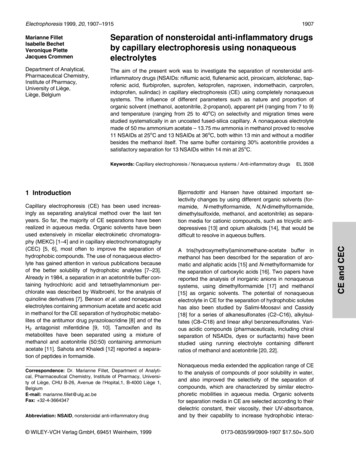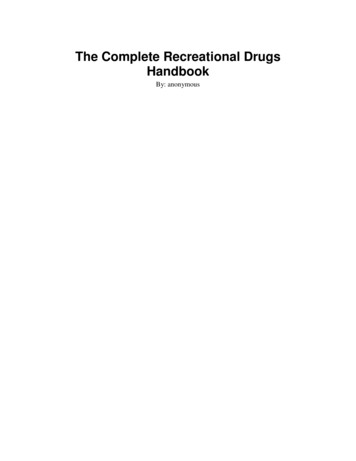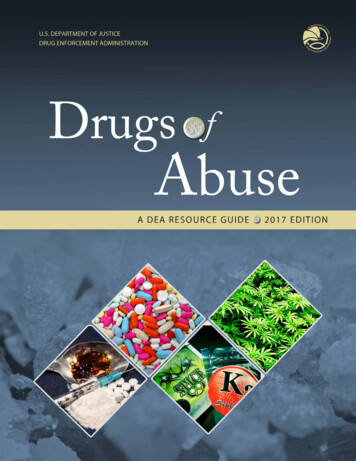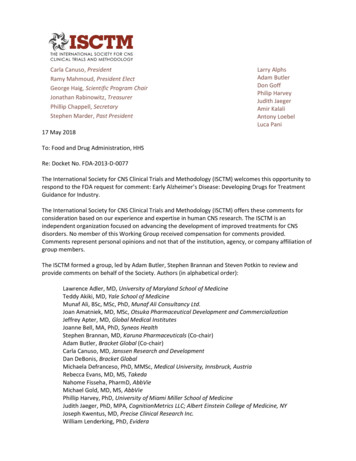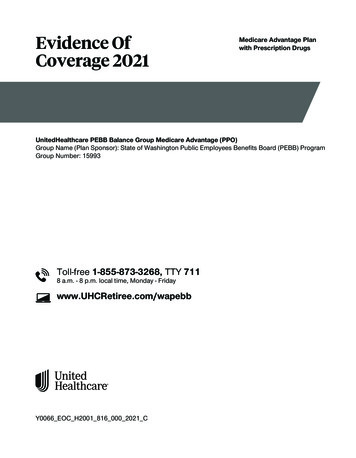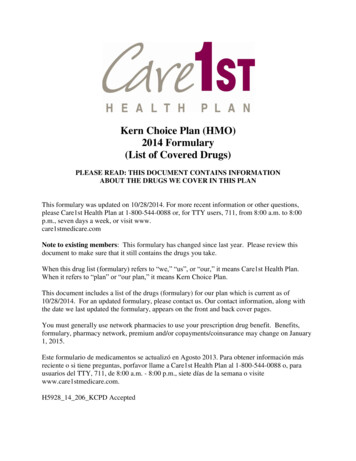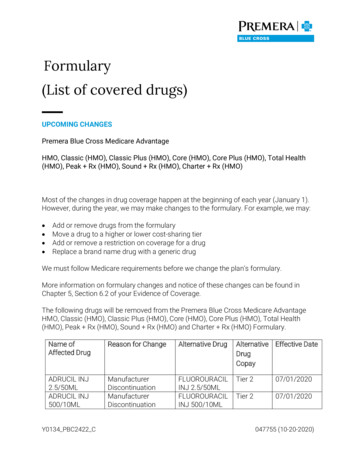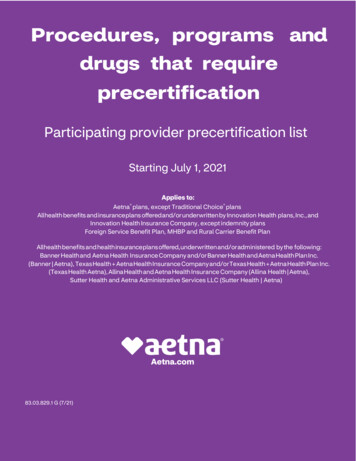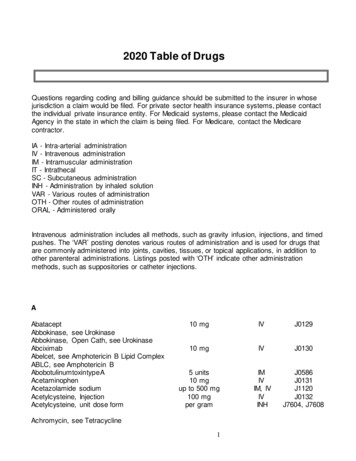
Transcription
Grades 3 to 5 Health Problems SeriesDrugsKidsHealth.org/classroomTeacher’s GuideThis guide includes: StandardsDrugs are chemicals that change the way a person’s body works. Some are legal,like medicines prescribed by doctors or sold in stores. For adults, cigarettes andalcohol are legal drugs, too. But cigarettes and alcohol are illegal for kids andteens. It’s also illegal ― and dangerous ― for kids to abuse medicines or use drugslike marijuana or cocaine. These activities will help your students understand howdrugs can hurt their bodies. They’ll also help kids learn how to deal with peerpressure and live a drug-free lifestyle. Related Links Discussion Questions Activities for Students Reproducible MaterialsRelated KidsHealth LinksArticles for Kids:What You Need to Know About dsDealing With Peer PressureThis guide correlates withthe following National HealthEducation Standards:Students will: Comprehend concepts relatedto health promotion anddisease prevention to enhancehealth. Analyze the influence offamily, peers, culture, media,technology, and other factorson health behaviors. Demonstrate the ability toaccess valid information andproducts and services toenhance health. Demonstrate the ability to useinterpersonal communicationskills to enhance health andavoid or reduce health risks. Demonstrate the ability touse decision-making skills toenhance health. Demonstrate the ability to usegoal-setting skills to enhancehealth. Demonstrate the ability topractice health-enhancingbehaviors and avoid or reducehealth risks. Demonstrate the ability toadvocate for personal, family,and community hool .htmlDiscussion QuestionsNote: The following questions are written in language appropriate for sharingwith your students. Show the questions on an overhead projector, whiteboard, orflipchart to use as a basis for the first activity.1.What’s a drug? Can you name some drugs? What do drugs do to your body andmind?2.What kinds of drugs are found in drinks, household products, and medicines?How are they abused?3.What kinds of drugs are illegal? Why do some kids and teens use illegal drugseven though they’re dangerous?4.What’s an addiction? Why do some people get addicted to drugs?5.Have you ever been pressured to do something you didn’t want to do? How didyou deal with it?National Health EducationStandards: m 2016 The Nemours Foundation/KidsHealth. Reproduction permitted for individual classroom use.
Grades 3 to 5 Health Problems SeriesDrugsActivities for StudentsNote: The following activities are written in language appropriate for sharing with your students.Show What You Know About DrugsObjectives:Students will: Read the KidsHealth.org article “What You Need to Know About Drugs” and complete the “Show What YouKnow About Drugs” handout Name three benefits of a drug-free lifestyle Design a pledge form or poster that includes a promise to stay drug-freeMaterials: “Show What You Know About Drugs” handoutEasel paper, poster board, or construction paperMagazinesArt supplies (pens, markers, or crayons)Class Time:2 sessions, 45 minutes eachActivities:Session 1: Today we’re going to gather information so we can create posters with a promise to stay drug-free. Togather the information, you’ll need to read this KidsHealth.org article, “What You Need to Know About Drugs,”with a partner and complete the “Show What You Know About Drugs” handout. But first, please read the questionson the handout, and while you’re reading the article, highlight information in the article that will help you answerthe questions in the handout. After you complete the handout, we’ll get back together as a class to discuss thequestions as a group.Session 2: Now we’re going to design posters that include a promise to be drug-free. First, we’ll talk about whyit’s good to live a drug-free lifestyle. [Note to instructor: Help students come up with examples like “keep yourbody and mind healthy,” “show respect for yourself,” “get good grades,” “keep friendships,” “be able to meet yourgoals,” “participate in school activities,” “obey the law,” “stay safe,” etc.] When designing your posters, include atleast three benefits for living a drug-free lifestyle. The title of each poster should be “I PROMISE TO BE DRUGFREE!” You can add drawings and pictures from magazines that show a drug-free lifestyle. At the bottom of theposter, sign your name and date it as a pledge to yourself and your loved ones who want you to stay drug-free.[Posters can be hung in the classroom and hallways or taken home as reminders.]Extensions:1.Create one “I PROMISE TO BE DRUG-FREE!” class poster with all students’ signatures to hang in the classroom.2.Have students create a Venn diagram with overlapping circles comparing illegal and legal drugs. In the areawhere the circles meet, list drugs that can be illegal and legal. Follow with a discussion about why a drug can beboth legal and illegal based on how it is used. 2016 The Nemours Foundation/KidsHealth. Reproduction permitted for individual classroom use.
Grades 3 to 5 Health Problems SeriesDrugsPeer Pressure SituationsObjectives:Students will: Read and discuss the KidsHealth.org article “Dealing With Peer Pressure”Role-play scenarios that demonstrate positive and negative peer pressureLearn strategies to help them deal with both kinds of peer pressureMaterials: KidsHealth.org article “Dealing With Peer Pressure”“Peer Pressure Situations” handoutClass Time:45 minutesActivity:Today we’ll read the KidsHealth.org article “Dealing With Peer Pressure,” then act out times you may have feltpressured by your friends. Peer pressure can be negative or positive. Maybe a friend helped you decide to play asport or pushed you to study for a test. Or maybe a friend asked you to help shoplift something or take a sip of wineat an adult party. But it’s up to you to make the right choice, to surround yourself with friends who are positive, andto say “No” and walk away when you know it’s wrong. Learning to resist and do what’s right is how you learn torespect yourself. The class will be divided into small groups. Each group will be given a different situation in whichpeer pressure is involved. The groups will act out a short scene for the class and we’ll decide whether the peerpressure is negative or positive. We’ll also discuss how to use resistance and ways to deal with negative pressure, orhow to use acceptance when it’s positive.Extensions:1.Ask students to brainstorm their own positive and negative peer pressure situations.2.Have your students ask parents or caregivers to talk about times they were pressured to do something when theywere young and how they handled the situations.Reproducible MaterialsHandout: Show What You Know About drugs handout1.pdfHandout: Peer Pressure rugs/drugs handout2.pdfQuiz: drugs quiz.pdfAnswer Key: drugs quiz answers.pdfKidsHealth.org is devoted to providing the latest children’s health information. The site, which is widelyrecommended by educators, libraries, and school associations, has received the “Teachers’ Choice Awardfor the Family” and the prestigious Pirelli Award for “Best Educational Media for Students.” KidsHealth comesfrom the nonprofit Nemours Foundation. Check out www.KidsHealth.org to see the latest additions! 2016 The Nemours Foundation/KidsHealth. Reproduction permitted for individual classroom use.
Health Problems SeriesDrugsPartner names:andDate:Show What You Know About DrugsInstructions: With your partner, read the KidsHealth.org article “What You Need to Know About Drugs,” then answer thefollowing questions so you’ll be prepared to participate in a class discussion.1What’s a drug? Can you name some drugs? What do drugs do to your body and mind?2What kinds of drugs are found in drinks, household products, and medicines? How are they abused?3What kinds of drugs are illegal? Why do some kids and teens use illegal drugs even though they’re dangerous?4What’s an addiction? Why do some people get addicted to drugs?5Have you ever been pressured to do something you didn’t want to do? What did you do? Could you have handledit differently? 2016 The Nemours Foundation/KidsHealth. Reproduction permitted for individual classroom use.
Health Problems SeriesDrugsPeer Pressure SituationsNote to instructor: Cut out each situation and hand it to a small group so students can prepare a brief skit demonstratingpeer pressure. Then the class can discuss whether each situation is negative or positive peer pressure, and ways to dealwith the negative pressure.Situation 1 You love to sing and want to join chorus, but all your friends are in sports andthey think chorus is for the birds.Situation 2 Your parents are hosting a neighborhood party and are serving wine and beerto adults. Your friends want you to sneak a beer to taste it.Situation 3 Your friends are pushing you to be in the talent show. You have stage fright,but you really want to be in the show.Situation4 Your best friend isn’t considered “cool” and some other friends of yours aregossiping about her. They want you to join in on talking badly about your best friend.Situation 5 Two of your friends are smoking, and ask if you want to smoke with them.Situation 6 You and your friends are playing on the school field over the weekend. One ofyour friends dares you to throw a rock at a school window. 2016 The Nemours Foundation/KidsHealth. Reproduction permitted for individual classroom use.
Health Problems SeriesDrugsName:Date:QuizInstructions: Answer each question.that change the way a person’s body and mind works.1.Drugs are2.True or false: Medicines are legal drugs. T F3.List three illegal drugs:4. List two reasons why illegal drugs are dangerous:5.A person who uses drugs can become6. List three signs that someone may be using drugs:7.Ais a drug that slows you down.8.Athere or think things that aren’t true.is a drug that changes people’s moods and makes them hear or see things that aren’t9. Name one thing you can do if you think someone you know is using drugs., or dependent on them.10. When someone your age tries to influence how you act or get you to do something, it’s called11. List two reasons why kids give into peer pressure:12. List two ways you can “walk away” from peer pressure:13. Who can you talk to if you’re feeling pressured to do something that’s not healthy? 2016 The Nemours Foundation/KidsHealth. Reproduction permitted for individual classroom use.
Health Problems SeriesDrugsQuiz Answer Keychemicals1.Drugs are2.True or false: Medicines are legal drugs. T F3.List three illegal drugs:Any three of the following; nicknames are acceptable: marijuana, cocaine, crack, heroin, tranquilizers and otherdepressants, methamphetamines, inhalants, LSD and other hallucinogens, Ecstasy4. ist two reasons why illegal drugs are dangerous:LAny two of the following: damage the heart and other important organs; lead to addiction; lead to death; lead to prison;result in harmful behavior; make kids less able to do well in school, sports, or other activities5.A person who uses drugs can become6. ist three signs that someone may be using drugs:LAny three of the following: lose interest in school; change friends (to hang out with kids who use drugs); become moody,negative, cranky, or worried all the time; ask to be left alone a lot; have trouble concentrating; sleep a lot (maybe even inclass); get in fights; have red or puffy eyes; lose or gain weight; cough a lot; have a runny nose all of the time7.A8.Ahallucinogenthere or think things that aren’t true.9. ame one thing you can do if you think someone you know is using drugs.NTell an adult you trust or choose not to try or use drugsdepressantthat change the way a person’s body and mind works.addicted, or dependent on them.is a drug that slows you down.is a drug that changes people’s moods and makes them hear or see things that aren’t10. When someone your age tries to influence how you act or get you to do something, it’s calledpeer pressure11. List two reasons why kids give into peer pressure:Any two of the following: to be liked, to fit in, worry they will be made fun of, everyone’s doing it, poor judgment12. List two ways you can “walk away” from peer pressure:Any two of the following: listen to your own feelings, enlist a friend to resist as well, choose friends wisely, stay away frompeers who are doing things that are wrong, ask an adult to help, say “No”13. Who can you talk to if you’re feeling pressured to do something that’s not healthy?Any one of the following: parents or guardians, adult relatives, teachers, school counselors, older siblings, clergy 2016 The Nemours Foundation/KidsHealth. Reproduction permitted for individual classroom use.
Read and discuss the KidsHealth.org article “Dealing With Peer Pressure” Role-play scenarios that demonstrate positive and negative peer pressure Learn strategies to help them deal with both kinds of peer pressure . Materials: KidsHealth.org article “Dealing With Peer Pressure” “Peer Pressure Situations” handout. Class Time: 45 minutes Activity: Today we’ll .

